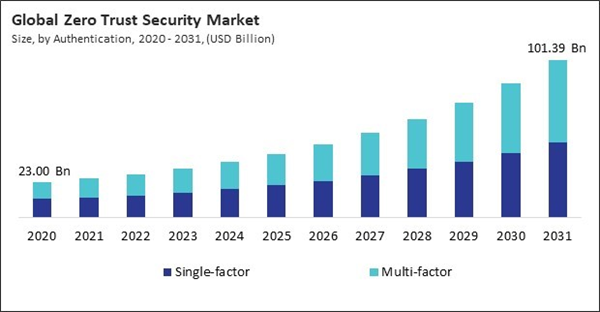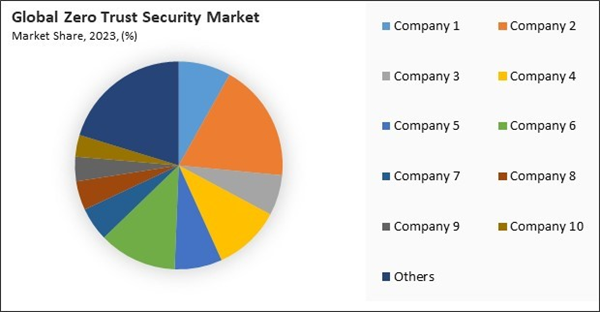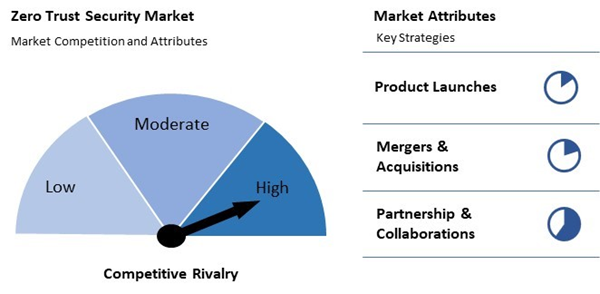The Global Zero Trust Security Market size is expected to reach $101.39 billion by 2031, rising at a market growth of 16.1% CAGR during the forecast period.
The North America segment recorded 34% revenue share in the market in 2023. This dominance was driven by the high adoption of advanced cybersecurity solutions, stringent regulatory frameworks, and the increasing frequency of cyber threats targeting enterprises and government institutions. The presence of major cybersecurity vendors, growing investments in cloud security, and the rapid expansion of remote work environments further fuelled the demand for zero-trust security solutions across industries such as BFSI, healthcare, and IT & telecom.
The major strategies followed by the market participants are Partnerships as the key developmental strategy to keep pace with the changing demands of end users. For instance, In November, 2024, Cisco Systems, Inc. and LTIMindtree expanded their partnership to offer next-generation Secure Access Service Edge (SASE) solutions, incorporating Zero Trust Network Access (ZTNA) and AI. This collaboration enhances secure hybrid work experiences and simplifies IT management for global clients. Moreover, In February, 2025, Check Point Software and Wiz have partnered to enhance hybrid cloud security by integrating cloud network security with Cloud Native Application Protection (CNAPP). This collaboration aims to provide unified security insights, optimized operations, and strengthened protection, aligning with Zero Trust principles.
The leading players in the market are competing with diverse innovative offerings to remain competitive in the market. The above illustration shows the percentage of revenue shared by some of the leading companies in the market. The leading players of the market are adopting various strategies in order to cater demand coming from the different industries. The key developmental strategies in the market are Partnerships & Collaborations.
The Zero Trust Security Market remains highly competitive, driven by emerging cybersecurity startups, niche solution providers, and regional firms. Companies focus on innovation, AI-driven authentication, and adaptive access controls to gain traction. Strategic partnerships, cloud-native security, and compliance-driven solutions help smaller players compete, fostering a dynamic landscape with continuous advancements in zero-trust frameworks and threat mitigation strategies.
The North America segment recorded 34% revenue share in the market in 2023. This dominance was driven by the high adoption of advanced cybersecurity solutions, stringent regulatory frameworks, and the increasing frequency of cyber threats targeting enterprises and government institutions. The presence of major cybersecurity vendors, growing investments in cloud security, and the rapid expansion of remote work environments further fuelled the demand for zero-trust security solutions across industries such as BFSI, healthcare, and IT & telecom.
The major strategies followed by the market participants are Partnerships as the key developmental strategy to keep pace with the changing demands of end users. For instance, In November, 2024, Cisco Systems, Inc. and LTIMindtree expanded their partnership to offer next-generation Secure Access Service Edge (SASE) solutions, incorporating Zero Trust Network Access (ZTNA) and AI. This collaboration enhances secure hybrid work experiences and simplifies IT management for global clients. Moreover, In February, 2025, Check Point Software and Wiz have partnered to enhance hybrid cloud security by integrating cloud network security with Cloud Native Application Protection (CNAPP). This collaboration aims to provide unified security insights, optimized operations, and strengthened protection, aligning with Zero Trust principles.
Cardinal Matrix-Market Competition Analysis
Based on the Analysis presented in the Cardinal matrix; Microsoft Corporation is the forerunners in the Zero Trust Security Market. In August, 2024, Microsoft Corporation partnered with NIST to launch a Zero Trust practice guide, offering practical steps for implementation. This collaboration aims to support the expanding Zero Trust security market, helping organizations adopt secure models to mitigate risks and strengthen cybersecurity. Companies such as Cisco Systems, Inc. and IBM Corporation are some of the key innovators in Zero Trust Security Market.Market Growth Factors
The rapidly evolving cyber threat landscape is one of the primary drivers for the growth of the market. Organizations across industries are experiencing an alarming rise in cyberattacks, including ransomware, phishing, insider threats, and advanced persistent threats (APTs). These attacks are becoming more sophisticated, leveraging artificial intelligence (AI) and machine learning (ML) to bypass traditional security measures. Thus, the increasing awareness about the necessity of cybersecurity, coupled with strict data protection regulations, is fuelling the growth of the market.Additionally, the growing adoption of IoT and connected devices in healthcare, manufacturing, smart cities, and financial services has created significant security challenges. IoT devices, including smart sensors, industrial controllers, medical equipment, and connected vehicles, often lack robust security measures, making them vulnerable to cyberattacks. Many of these devices operate with default credentials, outdated firmware, and unpatched vulnerabilities, allowing hackers to exploit them as entry points into enterprise networks. In conclusion, as industries continue integrating IoT technologies, the demand for zero trust security will rise significantly, driving market growth.Market Restraining Factors
However, Implementing a zero trust security framework requires a significant upfront investment in advanced security technologies, including identity and access management (IAM), endpoint security, multi-factor authentication (MFA), network segmentation, and behavioural analytics. Organizations must also allocate resources for integrating zero trust security with existing IT infrastructure, which can be complex and costly. These costs can be a major deterrent to adoption for small and medium-sized enterprises (SMEs) with limited cybersecurity budgets. Hence, high initial investment and ongoing operational costs are impeding the growth of the market.The leading players in the market are competing with diverse innovative offerings to remain competitive in the market. The above illustration shows the percentage of revenue shared by some of the leading companies in the market. The leading players of the market are adopting various strategies in order to cater demand coming from the different industries. The key developmental strategies in the market are Partnerships & Collaborations.
Driving and Restraining Factors
Drivers
- Increasing Frequency And Sophistication Of Cyberattacks
- Increasing Demand For Secure Access To The Internet Of Things (Iot) And Connected Devices
- Rising Digital Transformation And Cloud Migration
Restraints
- High Initial Investment And Ongoing Operational Costs
- Potential Network Performance And Latency Issues
Opportunities
- Rising Government Initiatives And Regulations Encouraging Zero Trust Security Adoption
- Expansion Of 5G Networks And Edge Computing
Challenges
- Cybersecurity Skills Shortage And Lack Of Trained Professionals
- Complex And Time-Consuming Implementation Process
Authentication Outlook
Based on authentication, the market is characterized into single-factor and multi-factor. The multi-factor segment procured 49% revenue share in the market in 2023. Rising concerns over cyber threats, data breaches, and identity fraud have fuelled the demand for stronger authentication mechanisms. Multi-factor authentication (MFA), which combines two or more verification factors - such as passwords, biometrics, and OTPs - enhances security by reducing the risk of unauthorized access, making it an essential component for industries handling sensitive data, including BFSI, healthcare, and government sectors.Deployment Outlook
By deployment, the market is divided into cloud and on-premises. The on-premises segment witnessed 39% revenue share in the market in 2023. This is driven by the preference of large enterprises and government organizations for greater control over their security infrastructure. On-premises deployment offers enhanced data protection, compliance with regulatory requirements, and reduced reliance on third-party cloud providers.Enterprise Size Outlook
Based on enterprise size, the market is segmented into SMEs and large enterprises. The SMEs segment acquired 36% revenue share in the market in 2023. With the growing adoption of digital transformation and cloud-based solutions, SMEs increasingly recognize the need for strong cybersecurity measures. Zero-trust security offers SMEs scalable and cost-effective protection against cyberattacks, insider threats, and unauthorized access. It is an essential strategy for ensuring data security and business continuity in an evolving threat landscape.Type Outlook
On the basis of type, the market is classified into network security, data security, endpoint security, on-premises security, and others. The data security segment recorded 24% revenue share in the market in 2023. With the growing volume of sensitive data generated and stored across cloud and hybrid environments, organizations are prioritizing data-centric security models. Zero-trust frameworks focus on encryption, access controls, and continuous monitoring to protect critical data from breaches, unauthorized modifications, and insider threats, driving demand for robust data security solutions.End Use Outlook
By end use, the market is divided into BFSI, healthcare, retail, IT & telecom, and others. The IT & telecom segment procured 22% revenue share in the market in 2023. The rapid expansion of cloud computing, 5G networks, and IoT connectivity has increased cybersecurity risks in the IT and telecom industry. Zero-trust security solutions protect network infrastructure, prevent unauthorized access, and secure data exchanges across distributed systems. With growing concerns over data privacy and cyber espionage, IT and telecom companies prioritize zero-trust models to enhance security resilience.Market Competition and Attributes
The Zero Trust Security Market remains highly competitive, driven by emerging cybersecurity startups, niche solution providers, and regional firms. Companies focus on innovation, AI-driven authentication, and adaptive access controls to gain traction. Strategic partnerships, cloud-native security, and compliance-driven solutions help smaller players compete, fostering a dynamic landscape with continuous advancements in zero-trust frameworks and threat mitigation strategies.
Regional Outlook
Region-wise, the market is analyzed across North America, Europe, Asia Pacific, and LAMEA. The Europe segment witnessed 30% revenue share in the market in 2023. The region’s strong emphasis on data privacy regulations, including GDPR, has accelerated the adoption of zero-trust frameworks among enterprises looking to enhance their cybersecurity posture. Increasing cyberattacks on financial institutions, government agencies, and healthcare providers have prompted European organizations to invest in robust security solutions, including network segmentation, continuous authentication, and endpoint security.Recent Strategies Deployed in the Market
- Jan-2025: IBM Corporation has acquired Applications Software Technology to strengthen its Oracle Cloud expertise, with a focus on public sector cloud transformations, enhancing its ability to support clients in North America, the UK, and Ireland with Oracle Cloud solutions.
- Dec-2024: Microsoft Corporation expands its product offerings to support U.S. government agencies in adopting Zero Trust principles, aligning with the CISA Zero Trust Maturity Model. Key services like Entra ID and Defender XDR enhance identity management, security, and risk-based access control.
- Aug-2024: Fortinet, Inc. acquired Lacework, enhancing its cloud-native security capabilities by integrating Lacework's platform with Fortinet's Security Fabric, bolstering its AI-driven, Zero Trust security solutions for comprehensive protection across cloud and on-premises environments.
- May-2024: Palo Alto Networks and IBM announced a partnership to provide AI-powered security solutions. IBM will integrate Palo Alto Networks' platforms, including Cortex XSIAM and Prisma SASE 3.0, for advanced threat protection and zero-trust security in hybrid cloud and AI environments.
- May-2024: CrowdStrike Holdings, Inc. and Cloudflare expanded their partnership to enhance security with a combination of Zero Trust protection and AI-native cybersecurity. This collaboration strengthens defense across networks, devices, endpoints, cloud, identity, data, and applications, aiming to prevent breaches at scale.
List of Key Companies Profiled
- Broadcom, Inc.
- Microsoft Corporation
- Fortinet, Inc.
- Palo Alto Networks, Inc.
- IBM Corporation
- Cisco Systems, Inc.
- Cloudflare, Inc.
- Check Point Software Technologies Ltd.
- CrowdStrike Holdings, Inc.
- Forcepoint LLC (Francisco Partners)
Market Report Segmentation
By Authentication
- Single-factor
- Multi-factor
By Deployment
- Cloud
- On-Premises
By Enterprise Size
- Large Enterprises
- SMEs
By Type
- Network Security
- Data Security
- Endpoint Security
- On-premises Security
- Other Type
By End Use
- BFSI
- IT & Telecom
- Retail
- Healthcare
- Other End Use
By Geography
- North America
- US
- Canada
- Mexico
- Rest of North America
- Europe
- Germany
- UK
- France
- Russia
- Spain
- Italy
- Rest of Europe
- Asia Pacific
- China
- Japan
- India
- South Korea
- Singapore
- Malaysia
- Rest of Asia Pacific
- LAMEA
- Brazil
- Argentina
- UAE
- Saudi Arabia
- South Africa
- Nigeria
- Rest of LAMEA
Table of Contents
Chapter 1. Market Scope & Methodology
Chapter 2. Market at a Glance
Chapter 3. Market Overview
Chapter 4. Competition Analysis - Global
Chapter 5. Global Zero Trust Security Market by Authentication
Chapter 6. Global Zero Trust Security Market by Deployment
Chapter 7. Global Zero Trust Security Market by Enterprise Size
Chapter 8. Global Zero Trust Security Market by Type
Chapter 9. Global Zero Trust Security Market by End Use
Chapter 10. Global Zero Trust Security Market by Region
Chapter 11. Company Profiles
Companies Mentioned
- Broadcom, Inc.
- Microsoft Corporation
- Fortinet, Inc.
- Palo Alto Networks, Inc.
- IBM Corporation
- Cisco Systems, Inc.
- Cloudflare, Inc.
- Check Point Software Technologies Ltd.
- CrowdStrike Holdings, Inc.
- Forcepoint LLC (Francisco Partners)
Methodology

LOADING...













